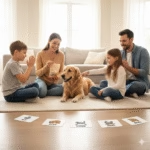The Longest Car Ride of Your Life
I can still feel the butterflies. They were a chaotic mix of pure joy and stomach-churning anxiety. In a travel crate in the back of my car was our eight-week-old Golden Retriever, Charlie. He was finally, really coming home. But as I drove, my mind wasn’t just on the tiny creature whining softly behind me. It was on the two slightly-less-tiny creatures waiting impatiently by the front window: my kids, ages four and seven.
This single moment—the first time my children would meet their new puppy—felt monumental. I knew, instinctively, that it wasn’t a moment to leave to chance. A chaotic, overwhelming, or frightening first encounter could plant seeds of fear or anxiety in either the puppy or the kids, creating issues we’d have to work to undo later. A calm, positive, and carefully orchestrated introduction, however, could lay the foundation for the trusting, loving bond I dreamed of.
Many people treat this moment like a surprise party. They open the door, unleash the puppy, and hope for the best in a flurry of squeals and wagging tails. I’m here to tell you, from one parent to another, that this is one of the most important moments to plan. This isn’t just about managing chaos; it’s about choreographing confidence. Here is the exact step-by-step playbook I used to make that first introduction a resounding success.
Phase 1: The Week Before “Gotcha Day” – Preparing Your Crew
The success of day one is determined by the preparation you do on day zero. The actual introduction is just the final scene of a play you’ve been rehearsing all week.
H3: Building the “Puppy Palace” (aka The Safe Zone)
Before your puppy even sets a paw in your house, you need to establish their personal sanctuary. For us, this was a large, comfortable crate in a corner of our living room, attached to a small, enclosed playpen area. This isn’t a cage; it’s their bedroom. It’s a critical tool for house training and safety, but its most important job on day one is to be a safe haven.
I assembled this a week in advance and introduced “The #1 Puppy Palace Rule” to my kids: When Charlie is in his palace, he is resting, and we do not bother him. We practiced this rule all week. They were allowed to help me put a soft blanket and a new toy inside, but they were not allowed to go in it themselves. This taught them to respect his personal space before he even arrived to claim it. It gave him an immediate, guaranteed escape from the pressures of his new world.
H3: The Family Meeting & The “Stuffed Puppy” Rehearsal
A few days before we picked up Charlie, I sat my kids down for a very important family meeting. I explained that puppies are a lot like human babies. They get scared by loud noises, they don’t know the rules yet, and they have very sharp teeth and nails even when they are just playing.
Then, I brought out our secret weapon: a life-sized stuffed Golden Retriever.
This was our stunt double. For the next few days, we practiced how to properly interact with “Stuffed Charlie.”
- “Gentle Hands, Not Grabby Hands”: We practiced petting with a soft, open palm on the stuffed dog’s back, not its face or head. We talked about how we never, ever pull ears or tails.
- “Let the Puppy Come to You”: We rehearsed sitting on the floor and letting the “puppy” come to us, rather than chasing it.
- “The Sniff Test”: I taught my seven-year-old how to hold out a closed fist for the “puppy” to sniff before trying to pet it. This is the polite canine handshake.
This role-playing wasn’t just for them; it was for me. It allowed me to see where my four-year-old’s impulses were and correct them in a zero-stakes environment. By the time the real Charlie arrived, they had already practiced the right way to behave a dozen times.
Phase 2: The Arrival – Choreographing Calm
The moment you pull into the driveway, your plan kicks into high gear. Excitement levels are at a fever pitch. Your job is to be the calm, confident director of this scene.
H3: The Neutral Ground: Your Backyard is the Stage
Do not carry the puppy directly into the house. A house is a confined space, and to a tiny puppy, a set of screaming, running children charging toward them in a hallway is the stuff of nightmares. The single best place for the first introduction is a secure, fenced-in backyard. It’s neutral territory and allows for more space.
Here was our exact process:
- I parked the car and went inside first, alone. My husband stayed in the car with Charlie.
- I greeted my kids calmly and said, “Okay team, it’s time to meet Charlie! Remember our rules? We’re going to go outside and sit on the grass and wait for him to come say hello.”
- I took them into the backyard and had them sit on a picnic blanket with me. Their excitement was visible, but by having them seated, I contained their physical energy.
H3: The Step-by-Step Introduction
Once the kids were calm and seated, my husband brought a leashed Charlie into the backyard.
- Potty First: The very first thing he did was take Charlie to a designated potty spot in the yard. This starts house training immediately and takes the pressure off the puppy.
- Let the Puppy Lead: With Charlie on a loose leash, my husband walked him gently around the yard, letting him sniff and get his bearings. He did not drag him toward the kids.
- Curiosity Takes Over: Naturally, Charlie’s puppy curiosity led him toward the strange little humans sitting on the blanket. The leash was kept loose to allow him to approach at his own pace.
- The First Contact: As he came closer, I quietly reminded the kids, “Okay, let him sniff you first.” Charlie sniffed their shoes and their hands. This is him gathering information. After a moment, I said, “Okay, gentle pets on his back.” Because we had rehearsed, they knew exactly what to do.
- Keep it Short and Sweet: After about 5-10 minutes of gentle pets and sniffing, I declared the first meeting a success. I said, “Okay, Charlie is getting tired. Let’s let him go explore his new house.” This ends the interaction on a high note before the puppy gets overwhelmed or the kids get too rowdy.
Phase 3: The First Hour Inside – Setting the Tone
Once inside, the calm, structured approach continues. A loose puppy in a new house with excited kids is a recipe for chaos.
H3: The Leashed Tour
For the first hour, Charlie remained on his leash, held by me. This prevented him from dashing off and chewing on a cord or getting cornered by my toddler. We took a slow, calm tour of the main living areas. The kids walked with us, but they were instructed not to chase or try to grab him. He was simply observing his new world with us as his calm guides.
H3: Introducing the “Puppy Palace” with a Prize
After the tour, I led him to his crate/pen area. I had a special chew toy (a Kong stuffed with a bit of peanut butter) waiting inside. I opened the door to the crate and tossed it in. I didn’t push him in. He curiously went in on his own to investigate the wonderful smell. This created an immediate, positive association with his personal space. He learned from minute one that his crate is where good things happen.
H3: The Rhythm of Play and Rest
Puppies, like toddlers, operate on a simple rhythm: play, potty, sleep, repeat. They cannot handle long periods of sustained interaction. After about 15-20 minutes of being in the house, I could see Charlie was getting tired and overstimulated. I announced, “It’s nap time for the puppy!” I took him for one more potty break, then calmly led him into his crate, gave him a small treat, and closed the door. He whimpered for a minute, then curled up and fell fast asleep.
This established the most important routine of all: that it’s okay to have downtime, and that the puppy’s needs dictate the schedule.
Conclusion: The First of a Thousand Perfect Moments
That first day wasn’t a chaotic free-for-all. It was quiet, it was structured, and it was, in its own way, perfect. It set the precedent for our entire life with Charlie. My kids learned from the very first interaction that he was a living being with his own needs and feelings, not a new toy. Charlie learned that these small humans were a source of gentle pets and calm energy, not something to be feared.
By taking the time to plan this one, single day, you aren’t just preventing a bad first impression. You are actively writing the first, beautiful chapter of a lifelong friendship.
A Real-Life Tip: My best trick for managing my kids’ overwhelming excitement during the introduction was to give them each a specific, important “job.” My older son was the “Official Quiet Captain,” whose job was to use hand signals to remind us all to use soft voices. My younger daughter was the “Chief Blanket Officer,” responsible for making sure the picnic blanket was perfectly smooth for our guest. Giving them a task channeled their nervous energy into a constructive purpose and made them feel like helpful participants in the plan rather than just kids being told what to do.

Rafael Souza is a digital marketing strategist and lifelong dog enthusiast. Passionate about Golden Retrievers, he shares practical, research-based tips to help owners provide healthier and happier lives for their furry companions.





